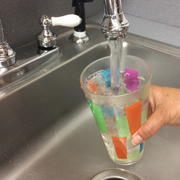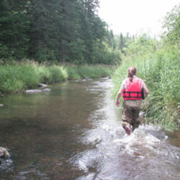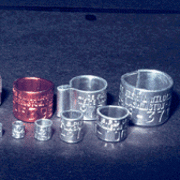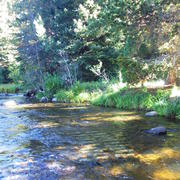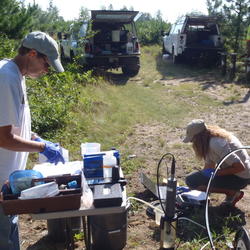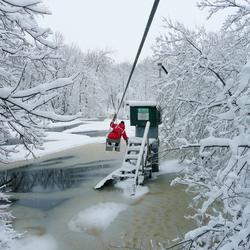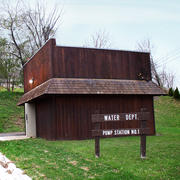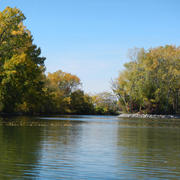Due to a lapse in appropriations, the majority of USGS websites may not be up to date and may not reflect current conditions. Websites displaying real-time data, such as Earthquake and Water and information needed for public health and safety will be updated with limited support. Additionally, USGS will not be able to respond to inquiries until appropriations are enacted. For more information, please see www.doi.gov/shutdown
Regions
Minnesota
States L2 Landing Page Tabs
In 1911, USGS personnel began measuring streamflow to aid in operation of reservoirs on the Mississippi River. From that fledgling start, the USGS Upper Midwest Water Science Center now provides data and interpreted science to more than 30 partners in federal, state, county and local governments to help manage and protect Minnesota’s groundwater and surface-water resources.
Link to Science CenterQuantifying changes in hydrology in response to land disturbance, land restoration, and increased water demand- Timothy Cowdery
The land of 10,000 lakes is a headwaters state, with glacial aquifers, rivers, prairie, forests, and vibrant urban areas. This project examines the human footprint on the hydrologic cycle--emphasizing aquifers and groundwater-surface water interaction. Your research will contribute to better understanding and management of Minnesota's water resources.
Do synthetic organophosphorus chemicals exacerbate harmful algal blooms in freshwater ecosystems?- Mark Brigham
Why did my lake turn green? Come work with USGS scientists in Minnesota and beyond to explore the relatively understudied role of synthetic organophosphorus compounds as one of a complex array of forces that drive harmful algal blooms. Then, tell the world what you discovered.
BOR environmental DNA sampling for invasive mussels at USGS gages
As part of an ongoing project funded by the Bureau of Reclamation and lead by the Idaho Water Sciences Center (IDWSC) and Northern Rocky Mountain Research Center (NOROCK), the Upper Midwest Environmental Sciences Center (UMESC) will analyze environmental DNA samples collected at gage stations directly downstream of multiple reservoirs throughout the Columbia River Basin. The goal of this...
Bird Banding Laboratory
The Bird Banding Laboratory (BBL) is an integrated scientific program established in 1920 supporting the collection, archiving, management and dissemination of information from banded and marked birds in North America. This information is used to monitor the status and trends of resident and migratory bird populations. Because birds are good indicators of the health of the environment, the...
Mining and Energy
Scientists are examining a number of issues to characterize potential effects of unconventional oil and gas development in the Bakken Shale within the Williston Basin, located in ND, SD and MT. Research is building upon current/ongoing studies to implement new, innovative research including water quality, water availability, ecological effects, proppant sand, and induced seismicity.
Flood Response
Floods are the leading cause of natural disaster losses, and Midwest Region scientists are ready to respond. Flood inundation maps tied to USGS real-time stream gage data and National Weather Service flood forecast sites enable state and local communities to make timely operational and public safety decisions during floods.
Potential Toxicity of Multiple Metals Associated with PGE Deposits
Water quality and aquatic life standards that are set by Federal and state regulatory agencies are used to evaluate the quality of our nation’s water and the health of aquatic ecosystems. These standards currently are based on hardness of the water and are determined for single metals, not for mixtures of metals that are typically found in natural systems. Metal mixtures can potentially be...
HDgov: Multi-agency Website for Human Dimensions of Natural Resources
HDgov is an interactive and mobile-responsive online portal to interagency, academic, and non-government resources focused on the human dimensions of natural resource management. The web portal provides easy access to tools, publications, data, and methods that help ensure that the people side of natural resources is considered throughout the entire natural resource management process. The...
National Park Service Visitor Spending Effects
The National Park Service (NPS) manages the Nation’s most iconic destinations that attract millions of visitors from across the Nation and around the world. Trip-related spending by NPS visitors generates and supports a considerable amount of economic activity within park gateway communities. USGS economists collaborate with the National Park Service social science program to estimate NPS...
North American Waterfowl Management Plan
The ultimate success of North American Waterfowl Management Plan (NAWMP) depends on maintaining relevance to stakeholders and society. In order to be relevant, a first step is to better understand what people value in regard to waterfowl and their habitats. Without this information, NAWMP population, habitat, and people objectives may not reflect stakeholder and societal values; and management...
Economic Impacts of Ecological Restoration
Federal investments in ecosystem restoration projects protect Federal trusts, ensure public health and safety, and preserve and enhance essential ecosystem services. These investments also generate business activity and create jobs. However, limited information exists on the costs and associated economic impacts of ecosystem restoration projects due to the complexity of the “restoration...
Crude Oil Contamination in the Shallow Subsurface
This investigation focuses on the long-term persistence in soils and groundwater of petroleum hydrocarbon spills, including crude oil and refined petroleum fuels. The study site near Bemidji, MN, is a laboratory for developing site assessment tools and understanding chemical changes affecting human and environmental health that occur during natural attenuation of petroleum hydrocarbons.
National Water Information System web interface (NWISweb)

The National Water Information System (NWIS) web application provides access to real-time and historical surface-water, groundwater, water-quality, and water-use data collected at approximately 1.5 million sites across all 50 states.
National Water Information System (NWIS) Mapper

The NWIS mapper provides access to over 1.5 million sites contained in the USGS National Water Information System (NWIS), including sites where current and historical surface-water, groundwater, springs, and atmospheric data has been collected. Users can search by site type, data type, site number, or place.
Structures Data
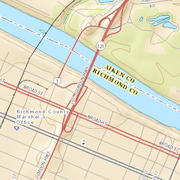
USGS data portray selected structures data, including the location and characteristics of manmade facilities. Characteristics consist of a structure's physical form (footprint), function, name, location, and detailed information about the structure. The types of structures collected are largely determined by the needs of the disaster planning and response and homeland security organizations.
Boundaries Data

Boundaries data or governmental units represent major civil areas including states, counties, Federal, and Native American lands, and incorporated places such as cities and towns.
Hydrography Data

The National Hydrography Dataset (NHD) and Watershed Boundary Dataset (WBD) are used to portray surface water on The National Map.
The United States Interagency Elevation Inventory (USIEI)

The USIEI is a comprehensive, nationwide listing of known high-accuracy topographic and bathymetric data for the United States and its territories. The project is a collaborative effort of the USGS and NOAA with contributions from other federal agencies. The inventory supports the 3D Elevation Program and the Integrated Ocean and Coastal Mapping effort. This resource is updated in Spring and Fall.
Elevation Data

The 3DEP products and services available through The National Map consist of lidar point clouds (LPC), standard digital elevation models (DEMs) at various horizontal resolutions, elevation source and associated datasets, an elevation point query service and bulk point query service. All 3DEP products are available, free of charge and without use restrictions.
Orthoimagery Data

Orthoimagery data typically are high resolution aerial images that combine the visual attributes of an aerial photograph with the spatial accuracy and reliability of a planimetric map. The National Map offers public domain, 1-meter orthoimagery for the conterminous United States with many urban areas and other locations at 2-foot or finer resolution.
The National Map Small-Scale Collection

The National Map offers a collection of small-scale datasets, most of which are at 1:1,000,000. The National Map publishes two data collections at one million-scale: one for Global Map users and one for National Map users. In terms of vector geometry, the lines, points, and areas in these data collections are identical. The difference is in the attributes assigned to these features.
FishVis Mapper
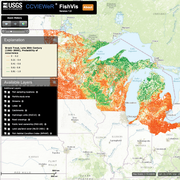
The FishVis Mapper is the product of an Upper Midwest and Great Lakes LCC project, “A Regional Decision Support Tool for Identifying Vulnerabilities of Riverine Habitat and Fishes to Climate Change” that developed an approach for predicting fish species occurrence under current climate conditions and project how fish species occurrence may change under future climate conditions.
Long Term Resource Monitoring

This web resource provides decision makers with the information needed to maintain the Upper Mississippi River System as a viable multiple-use large river ecosystem.
The FishVis Mapper is the product of an Upper Midwest and Great Lakes LCC project, “A Regional Decision Support Tool for Identifying Vulnerabilities of Riverine Habitat and Fishes to Climate Change” that developed an approach for predicting fish species occurrence under current climate conditions and project how fish species occurrence may change under future climate conditions.
The 3DEP products and services available through The National Map consist of standard digital elevation models (DEMs) at various horizontal resolutions, elevation source and associated datasets, an elevation point query service and bulk point query service. All 3DEP products are available, free of charge and without use restrictions.
This mapper displays SPARROW nutrient load and yield data and the importance of various nutrient sources for the RARB, given nutrient inputs similar to 2002. Rankings can be shown by country, state/province, HUC4, HUC8, and catchment. Nutrient data can be explored using maps and interactive graphs and tables. Modeling results can be exported as an Excel spreadsheet or a geospatial dataset.
Transport of nitrogen and phosphorus in the Cedar River Basin, Iowa and Minnesota, 2000–15
Nitrate concentrations in the Cedar River in Iowa and Minnesota have increased from an average of less than 1.0 milligram per liter in the early 1900s to more than 5.0 milligrams per liter in the 2000s and have resulted in periodic water-quality impairment of the river. Spatial differences and temporal changes in nitrogen and phosphorus transport...
Kalkhoff, Stephen J.Mercury and water level fluctuations in lakes of northern Minnesota
Large lake ecosystems support a variety of ecosystem services in surrounding communities, including recreational and commercial fishing. However, many northern temperate fisheries are contaminated by mercury. Annual variation in mercury accumulation in fish has previously been linked to water level (WL) fluctuations, opening the possibility of...
Larson, James H.; Maki, Ryan P.; Christensen, Victoria G.; Sandheinrich, Mark B.; LeDuc, Jaime F.; Kissane, Claire; Knights, Brent C.Geomorphic responses of Duluth-area streams to the June 2012 flood, Minnesota
In 2013, the U.S. Geological Survey, in cooperation with the Minnesota Pollution Control Agency, completed a geomorphic assessment of 51 Duluth-area stream sites in 20 basins to describe and document the stream geomorphic changes associated with the June 2012 flood. Heavy rainfall caused flood peaks with annual exceedance probabilities of less...
Fitzpatrick, Faith A.; Ellison, Christopher A.; Czuba, Christiana R.; Young, Benjamin M.; McCool, Molly M.; Groten, Joel T.Historical files from Federal Government mineral exploration-assistance programs, 1950 to 1974
The Defense Minerals Administration (DMA), Defense Minerals Exploration Administration (DMEA), and Office of Minerals Exploration (OME) mineral exploration programs were active over the period 1950–1974. Under these programs, the Federal Government contributed financial assistance in the exploration for certain strategic and critical minerals. The...
Frank, David G.A random-walk algorithm for modeling lithospheric density and the role of body forces in the evolution of the Midcontinent Rift
This paper develops a Monte Carlo algorithm for extracting three-dimensional lithospheric density models from geophysical data. Empirical scaling relationships between velocity and density create a 3D starting density model, which is then iteratively refined until it reproduces observed gravity and topography. This approach permits deviations from...
Levandowski, William Brower; Boyd, Oliver S.; Briggs, Richard; Gold, Ryan D.Isolation and molecular characterization of a novel picornavirus from baitfish in the USA
During both regulatory and routine surveillance sampling of baitfish from the states of Illinois, Minnesota, Montana, and Wisconsin, USA, isolates (n = 20) of a previously unknown picornavirus were obtained from kidney/spleen or entire viscera of fathead minnows (Pimephales promelas) and brassy minnows (Hybognathus hankinsoni). Following the...
Phelps, Nicholas B.D.; Mor, Sunil K.; Armien, Anibal G.; Batts, William N.; Goodwin, Andrew E.; Hopper, Lacey; McCann, Rebekah; Ng, Terry Fei Fan; Puzach, Corey; Waltzek, Thomas B.; Delwart, Eric; Winton, James; Goyal, Sagar M.Comparing catch orientation among Minnesota walleye, northern pike, and bass anglers
We compared the catch orientations of Minnesota walleye (Sander vitreus), northern pike (Esox lucius), largemouth bass (Micropterus salmoides), and smallmouth bass (Micropterus dolomieu) anglers. Results were derived from 2009, 2010, and 2012 surveys of anglers targeting these different species. Consistent with previous research, we identified...
Schroeder, Susan A.; Fulton, David C.Spot-mapping underestimates song-territory size and use of mature forest by breeding golden-winged warblers in Minnesota, USA
Studies of songbird breeding habitat often compare habitat characteristics of used and unused areas. Although there is usually meticulous effort to precisely and consistently measure habitat characteristics, accuracy of methods for estimating which areas are used versus which are unused by birds remains generally untested. To examine accuracy of...
Streby, Henry M.; Loegering, John P.; Andersen, David E.Use of early-successional managed northern forest by mature-forest species during the post-fledging period
In eastern North America, after the young fledge, both adult and juvenile mature-forest birds may use regenerating clearcuts, although which species frequent early-successional forest and during which life stages is not well documented. To assess whether birds nesting in mature forest in north-central Minnesota use regenerating clearcuts 2...
Streby, Henry M.; Peterson, Sean M.; McAllister, Tara L.; Andersen, David E.Northern goshawk monitoring in the western Great Lakes bioregion
Uncertainties about factors affecting Northern Goshawk (Accipiter gentilis) ecology and the status of populations have added to the challenge of managing this species. To address data needs for determining the status of goshawk populations, Hargis and Woodbridge (2006) developed a bioregional monitoring protocol based on estimating occupancy. The...
Bruggeman, Jason E.; Andersen, David E.; Woodford, James E.Estimated Withdrawals and Other Elements of Water Use in the Great Lakes Basin of the United States in 2005
Estimates of water withdrawals in the United States part of the Great Lakes Basin and 107 of its watersheds designated by the 8-digit hydrologic unit code (HUCs) indicate that about 30.3 billion gallons per day (Bgal/d) were withdrawn for practically all categories of use in 2005. Virtually all water withdrawn was freshwater. Surface-water...
Mills, Patrick C.; Sharpe, Jennifer B.Recovery of sediment characteristics in moraine, headwater streams of northern Minnesota after forest harvest
We investigated the recovery of sediment characteristics in four moraine, headwater streams in north-central Minnesota after forest harvest. We examined changes in fine sediment levels from 1997 (preharvest) to 2007 (10 years postharvest) at study plots with upland clear felling and riparian thinning, using canopy cover, proportion of...
Vondracek, Bruce C.; Merten, Eric C.; Hemstad, Nathaniel A.; Kolka, Randall K.; Newman, Raymond M.; Verry, Elon S.National Oil and Gas Assessment Provinces
This is a graphic from the USGS National Oil and Gas Assessment Explorer application, which allows user to drill into 70 oil and gas assessment provinces throughout the United States.
PAMF Participation Cycle
This video describes the annual participation cycle for those enrolled in the Phragmites Adaptive Management Framework (PAMF). PAMF encompasses three annual steps including enrolling, monitoring and managing. As participants employ management actions and submit monitoring reports they will receive management guidance generated by the PAMF model, which provides the most
...PAMF Participation Cycle (Audio-Described)
This video describes the annual participation cycle for those enrolled in the Phragmites Adaptive Management Framework (PAMF). PAMF encompasses three annual steps including enrolling, monitoring and managing. As participants employ management actions and submit monitoring reports they will receive management guidance generated by the PAMF model, which provides the most
...Red River at Oslo, MN (Streamgage 05083500)
USGS Hydrologic Technician Dan Thomas preparing to measure discharge using an acoustic doppler current profiler (ADCP) with a manned boat on the Red River at Oslo, MN (streamgage 05083500) on April 25, 2018. The ADCP measures water currents with sound, using a principle of sound waves called the Doppler effect. The ADCP works by transmitting "pings" of sound at a constant
...Landsat in Action - Minnesota Lakes with Leif Olmanson
Leif Olmanson from the University of Minnesota talks about the value of Landsat data in monitoring the thousands of lakes in Minnesota.
The Phragmites Adaptive Management Framework (PAMF)
This is an introductory video to an adaptive management approach for the invasive plant Phragmites australis in the Great Lakes basin. An adaptive management framework is an iterative process of robust decision making aimed at reducing uncertainty over time, for a variety of stakeholders with differing backgrounds and interests, via system monitoring.
USGS Scientists Collecting a Water Sample from a Well at the USGS Bemidji Research Site
U.S. Geological Survey (USGS) scientists collecting a groundwater sample from a well at the USGS Bemidji Crude-Oil Spill Research Site, Minnesota. The scientists monitored in real time the dissolved oxygen, pH, specific conductance, and temperature of the water as the well is pumped so they can know when to collect representative sample.
Measuring soil CO2 efflux
Measuring soil CO2 efflux at the Bemidji Crude Oil Spill research site
Big Fork River at Big Falls, Minnesota, April 13, 2011
USGS hydrologists recorded flood stage flow creating rapids on Big Fork River at Big Falls, MN on April 13, 2011
For more information about this flood and to view real-time streamflow information, go to http://mn.water.usgs.gov/
Keep up to date with
...Endocrine Disruptors and Intersex Fish in Minnesota Lakes
Endocrine disrupting chemicals were identified in all of the 11 Minnesota lakes studied by the U.S. Geological Survey, St. Cloud State University and the Minnesota Pollution Control Agency. Female characteristics were observed in male fish in most of the lakes studied. USGS scientists Jeffrey Writer talks to us about what's going on.
Roseau River near Malung Minnesota
Russ Buesing using a cable car to access a gage (05104500) in winter (March 26) on the Roseau River near Malun, MN.
Minnesota well drillers and landowners will now have new tools to help predict arsenic concentrations in drinking water when building domestic water wells, according to a recent U.S. Geological Survey study.
The reliability of arsenic testing for drinking water in Minnesota depends on how and when well water samples are collected, according to a new U.S. Geological Survey and the Minnesota Department of Health study, which highlights ways to improve the accuracy of arsenic tests for private wells.
The first great geologic expeditions of the United States set off in the mid-1800s, equipped with mules, rifles, and early scientific instruments. Their goal: to uncover the great mineral wealth of the United States and learn about its earliest geologic history.
A regional assessment of untreated groundwater in the Cambrian-Ordovician aquifer system, which includes parts of Minnesota, Wisconsin, Michigan, Iowa, Illinois, Missouri and Indiana, is now available from the U.S. Geological Survey.
Oxygen levels, dissolved minerals among factors responsible for high concentrations of radium in untreated water from aquifer that underlies six states
Both precipitation and groundwater withdrawals, among other factors, influence lake-water levels in the northeast Twin Cities metropolitan area, and the extent of these changes vary among lakes, according to a new U.S. Geological Survey study.
A carbonatite here, a glacial moraine there, a zig-zagging fault or two, even a behemoth of a batholith. The geology of the 50 States is an enormous patchwork of varied forms, beautiful in their variance but challenging to present as a single map.
In 2016, these five states led the pack in mineral production, accounting for about one third of the total mineral production value for the entire country.
Look, in the sky! It’s a bird! It’s a plane! It’s...underground mineral research?
Human and bovine, or cattle, viruses were detected in a small percentage of some Great Lakes Basin streams, with human viruses more prevalent in urban streams and bovine viruses more common in streams in agricultural areas, according to a recent U.S. Geological Survey-led study.
Bifenthrin combats pests, but may harm aquatic ecosystems


